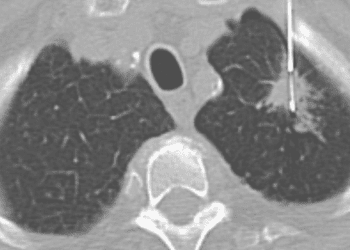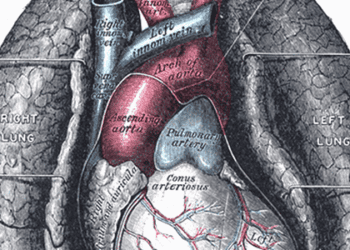High early mortality of lung cancer possibly due to missed diagnostic opportunities
1. In lung cancer patients from the United Kingdom, being older, male and more socioeconomically deprived, living in a rural versus urban location, and currently smoking were associated with early death within 90 days of diagnosis.
2. Lung cancer patients who died soon after diagnosis consulted their general practitioner more frequently and were less likely to have a chest x-ray performed by a primary care physician.
Evidence Rating Level: 2 (Good)
Study Rundown: Lung cancer survival rates in the United Kingdom (UK) are lower than other countries, in part due to higher rates of early mortality after diagnosis. In this study of patients in The Health Improvement Network (THIN), a longitudinal primary care dataset in the UK, patient and primary care factors were compared between lung cancer patients who died before and after 90 days post-diagnosis. Patients who died early were more likely to be men, of older age and current smokers, have higher levels of social isolation, be of lower socioeconomic status, and live in a rural versus urban location. Further, while early mortality was decreased in patients who had a chest x-ray (CXR) completed by a GP, increased CXR ordering by the GP was associated with greater early mortality of patients registered at the practice. This may be due to increased late stage lung cancer detection and hint at missed diagnostic opportunities.
Limitations of this study include lack of detailed information about lung cancer and treatment, including grade, stage, performance status, and any interventions in specialized care, such as radiation or chemotherapy. All of these factors likely have an influence on individual patients’ prognosis. Further, insufficient information is available about exact cause of death, and some reported deaths may have occurred due to comorbid conditions rather than lung cancer itself. The generalizability of these results may be somewhat limited by the overall health care system structure in the UK, in which many patients seek care through their GP prior to being evaluated by a specialist. However, data from THIN has been proven to offer a reliable record of lung cancer diagnosis, evaluation, and management in the primary care setting in the UK. Overall these results provide an understanding of patient characteristics and primary care management factors that are associated with early death in patients diagnosed with lung cancer. These results additionally suggest that while those who die early are interacting with primary care in the time leading to diagnosis and having a CXR may promote diagnosis, overall improved risk assessment is needed to reduce early mortality in lung cancer.
Click to read the study, published today in Thorax
Click to read an accompanying editorial in Thorax
Relevant Reading: Using socio-demographic and early clinical features in general practice to identify people with lung cancer earlier
In-Depth [retrospective cohort]: Data from 20,142 lung cancer patients from THIN were analyzed to study patient and primary care characteristics associated with early mortality (within 90 days) after lung cancer diagnosis. Early mortality, experienced by 30% of the study population, was further divided into immediate, within 1-30 days and between 30-90 days post-diagnosis. Logistic regression was used to calculated odds ratios (OR) for mortality after diagnosis in addition to multivariate regression with adjustment for covariates. In regression analysis, ORs were similar across the early death group classifications. Those who died within 90 days of diagnosis, age ≥80 was associated with early death (OR 1.80 [CI95% 1.62-1.99]) compared to age 65-69 years. In the adjusted analysis, current smokers vs. never smokers (OR 1.43 [CI95% 1.28-1.61]), males vs. females (OR 1.17 [CI95% 1.10-1.24]), and patients of lower socioeconomic status vs. higher socioeconomic status (OR 1.16 [CI95% 1.04-1.30]) had increased rates of early mortality. Additionally, patients who died within 90 days of diagnosis visited their GP more frequently than those who died 90 days more after diagnosis. While early mortality was lower in lung cancer patients who had a CXR performed in the primary care setting, increased CXR ordering from a GP’s office was associated with higher early lung cancer mortality in the practice.
More from this author: Risk of cerebral palsy linked with relatedness to cerebral palsy patient, Active commuting associated with a lower BMI, body fat, Association of obesity and dementia varies with age, Decrease in sedentary lifestyle associated with longer telomere length
Image: PD
©2012-2014 2minutemedicine.com. All rights reserved. No works may be reproduced without expressed written consent from 2minutemedicine.com. Disclaimer: We present factual information directly from peer reviewed medical journals. No post should be construed as medical advice and is not intended as such by the authors, editors, staff or by 2minutemedicine.com. PLEASE SEE A HEALTHCARE PROVIDER IN YOUR AREA IF YOU SEEK MEDICAL ADVICE OF ANY SORT.






